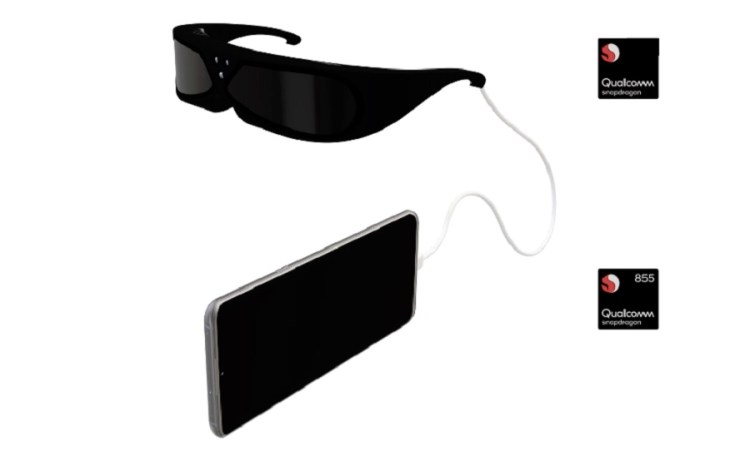Qualcomm has unveiled a new Qualcomm Snapdragon XR Smart Viewer reference design that makes it easier for hardware companies to create lightweight augmented reality glasses.
Qualcomm made the announcement ahead of the Augmented World Expo (AWE) event in Santa Clara, California. With this design, AR glasses can become smart viewers for AR content that is stored on a smartphone.
Inside these glasses, very little to no processing is happening. The lightweight glasses have high-resolution displays, as well as sensors that can track movement, hands, and eyes. But the glasses are connected via a wire to a smartphone or a computing puck. The processing happens in a device that is connected to the glasses, said Hugo Swart, head of XR at Qualcomm, in an interview with GamesBeat.
“We call it a simple viewer, with very limited processing done on the headset,” Swart said. “All the work is done on the phone or puck or PC. There are benefits to distributing the load on what you carry in the body and what you have in the head. So you can put a smaller Snapdragon chip on the headset to do 6DoF tracking and eye tracking and 3D reconstruction and movement and hand tracking.”
“Many operators have launched 5G networks already today,” Swart added. “The Nreal AR glasses paired with a smartphone are a very common use case that the operators are promoting.”
The reference design, built with the help of GoerTek, will enable a lot of manufacturers of smart glasses to jump into the space with AR and an VR smart viewers, Swart said.
“Our strategy is to build a chip, the XR1, with its software, and then a reference design,” he said. “When we bring a reference design out, the industry will pick it up and show it in commercial products at a later date.”
The Snapdragon Smart Viewer Reference Design features six-degrees-of-freedom (6DoF) movement for room scale XR experiences. With two dedicated 6DoF cameras for body tracking, users can walk around without the need for external motion sensors.
It also has full support for hand tracking and gesture tracking — with tap, zoom, pinch, and scroll features — which could be used for interactions with virtual objects.
And it has eye tracking. To reduce power consumption using foveated rendering, Qualcomm worked with eye-tracking firm Tobii to have integrated eye tracking. This provides superior intuitive interfaces and enables gaze direction for fast interactions within the virtual environment.
The reference design also supports 6DoF Controllers. These controllers are fundamental for interaction, especially in VR gaming. Snapdragon Smart Viewer VR Reference Design provides 6DoF controllers with the ability to support vision-based controllers for VR gaming and productivity applications.
The glasses also feature a display panel, built with JDI, to enable consumers to be immersed in their favorite content by supporting smooth experiences with 72KHz refresh rate and 2K resolution per eye. It works for both AR and virtual reality.
If needed, the reference design also supports standalone mode, where, in addition to tethering the headset via USB-C to a host device, the Snapdragon Smart Viewer Reference Design also delivers high-quality experiences in a mode where all the computing is done directly on the device. It taps into the XR1 heterogeneous compute architecture, including the Qualcomm Kryo CPU, Qualcomm Adreno GPU, Qualcomm Hexagon DSP, and Qualcomm AI Engine for high-performance VR applications like simple games, video streaming, and productivity applications, all running at low power consumption.
Swart is speaking at AWE 2019 on Thursday, and Qualcomm is doing demos in its booth at the show. Swart said he is very optimistic about the combination of AR, VR, 5G, and artificial intelligence.

